A Guide to Healthcare Software Pricing Models
Like most other industries, technological advancements are benefiting healthcare in numerous ways. Medical companies, as well as health institutions, are being forced to shift their focus to digital systems or healthcare software systems to increase transparency and efficiency.
Healthcare software can be defined as any software that was created to assist the medical industry. These tools also refer to knowledge-based and decision-support IT programs that provide feedback, assistance, and guidance in healthcare settings.
Digital technologies are helping healthcare organizations to optimize their staff management and provide a better quality of patient care with healthcare software. There are many types of healthcare software being utilized in hospitals and other healthcare companies, so let’s dive into these categories to discuss how they are priced.
How is healthcare software priced?
Pricing plays a pivotal role in achieving profitable growth in healthcare businesses. The cost of purchasing and installing software vary depending on whether you select on-site or web-based deployment. To estimate how much healthcare software ownership will cost your organization, you should consider software implementation components such as hardware, implementation assistance, training, and ongoing network fees along with maintenance fees. These cost elements relate to primary care settings, as opposed to hospitals which may have different cost structures.
Here are a few factors that affect pricing:
Consider whether you just need a single application (e.g., EHR or medical billing) or if you need to integrate what you purchase with other applications already in place, such as scheduling software.
What are the types of users that will access your system (i.e., doctors, nurses, practitioners, therapists, and physicians.)?
How many users need a unique login?
What type of pricing models are used in the healthcare software market?
When we evaluate healthcare software pricing, you’ll notice three main categories of pricing models: perpetual license, subscription license, and free and open source. You may already have a basic understanding of these options, but let’s consider the full upfront, recurring, and hidden costs of each.
Some basic pricing models for healthcare software are:
Subscription pricing model: The cloud-based deployment model has been widely adopted by vendors, along with the usual monthly and annual subscription licenses. Small healthcare companies often opt for subscription licenses, as their low upfront costs make them more budget friendly.
Perpetual pricing model: Large healthcare companies that maintain on-premise systems and in-house IT teams are more likely to choose perpetual licenses. Upfront costs can be large, but because the license fee is paid once, recurring costs are relatively low. Some vendors have converted completely to the cloud-based model, while others offer both subscription and perpetual licenses.
Freemium model: Open source software is flexible and usually free to download and develop. Companies with unique workflows and requirements can configure it to get exactly what they need while saving thousands of dollars in license fees. However, it’s important to note that costs for custom development can be significant if there is no in-house IT team to make those changes.
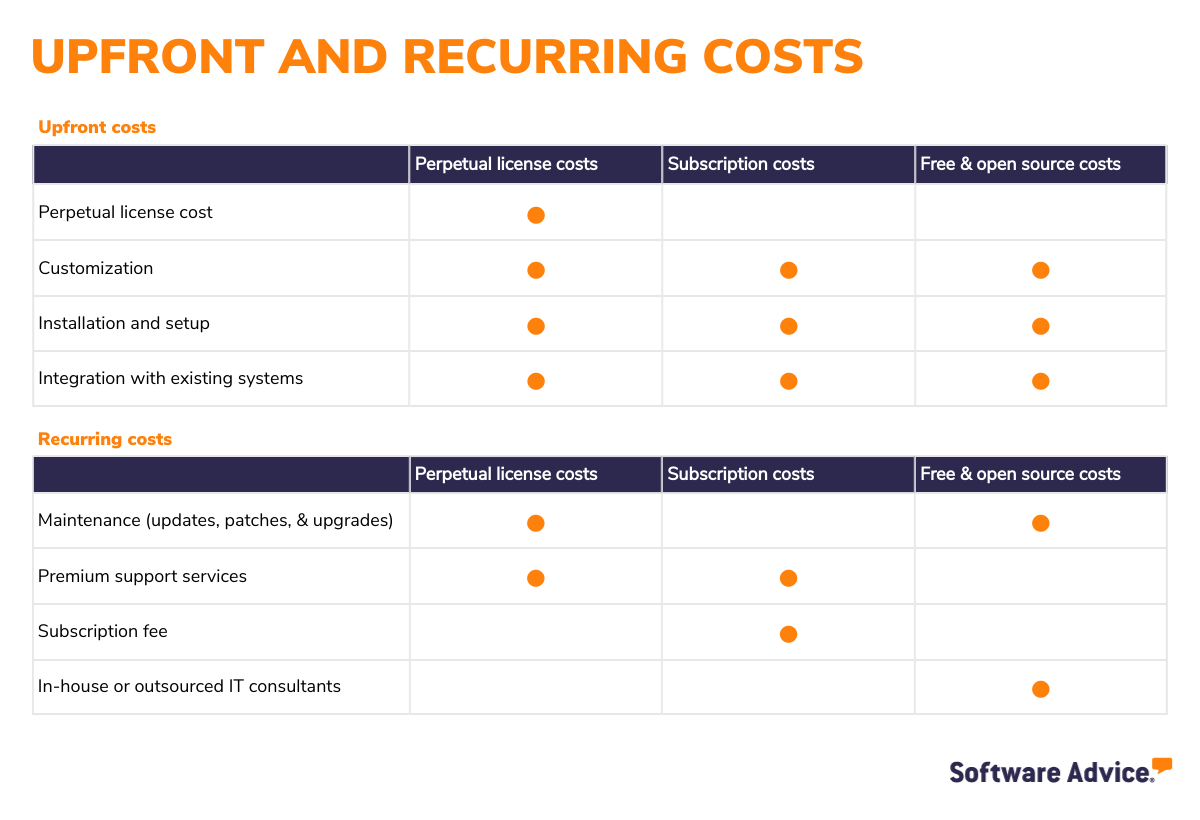
Typical price ranges for healthcare software
Healthcare software vendors, such as those in many other industries, typically offer subscription-based pricing models depending upon your current infrastructure and budget. Software-as-a-Service (SaaS) platforms typically operate on a fixed monthly subscription pricing model or “pay-as-you-go” model, and the initial setup cost for SaaS is usually lower than the equivalent perpetual license.
For more details on the subscription pricing ranges for each type of software, let’s take a look at different categories of healthcare software.
1. Electronic medical records (EMR) software
What it is:
EMR software automates the clinical operations of healthcare providers. It allows medical professionals to create, store, update, and share digital patient charts, histories, medications, test results, and more.
How much does EMR software cost?
The cost of any EMR solution is primarily based on two aspects such as the specific features and the number of physicians (users). EMR software usually operates on two types of pricing models—subscription license and perpetual license. However, the pay per provider model is most common for SaaS EMR solutions. In some instances SaaS model is paired with a “percent of collections” fee that yields free EMR access if you use the company’s billing software
Additional notes:
EMR software cost starts as low as $74 and can go as high as $729 for a single user per month. For more users and advanced functionalities, healthcare companies can expect to pay around $599 to $18,225+ per month.
We classify the different pricing plans as basic, premium, and advanced. The price for these three pricing ranges goes from lowest to highest as the basic plan covers just a few basic features of the EMR software, whereas premium plans cover more advanced features in addition to the basic features. Also, the advanced plan is the highest priced among the three due to more advanced features that support larger teams or enterprises. For reference, below is a snapshot of some popular EMR software.
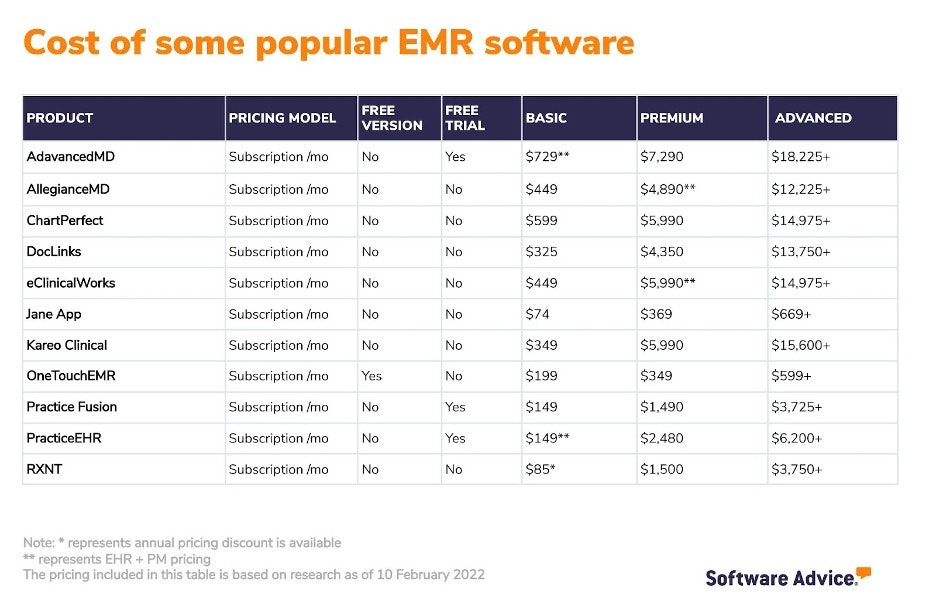
Only products with publicly-available pricing information were included in this table. We summarized publicly-available pricing sources, including vendor websites, as of February 10, 2022, beginning with the lowest monthly pricing (not including annual discounts) for packages that include the core functionality for a software category. We list pricing for more advanced packages (per user, when available) that also include the core software feature(s). As always, your company’s specific needs may differ and final pricing will vary.
A note on features:
EMR/EHR software automates the clinical operations of healthcare providers and allows medical professionals to create, store, update, and share digital patient charts, histories, medications, test results, and more. The core or basic functionalities include charting, decision support, and coding assistance.
2. Medical billing software
What it is:
Medical billing software helps healthcare providers track services, verify patients’ insurance, create and send invoices, and submit claims. It also helps you enter medical data and communicate in an efficient way with insurance companies, as well as patients, so that everyone remains on the same page regarding the bill rendered for services.
How much does medical billing software cost?
When it comes to medical billing software, the price depends upon the type of hosting service: self-hosted and cloud-based. With cloud-based options there is an important cost to note—the “cost per claim.” This cost is an additional cost to the monthly fee charged by medical practitioners for each successful claim.
Additional notes:
Medical billing software cost starts as low as $65 and can go as high as $599 for a single user per month. For more users and advanced functionalities, healthcare companies can expect to pay around $669 to $15,600+ per month.
We classify the different pricing plans as basic, premium, and advanced. The price for these three pricing ranges goes from lowest to highest as the basic plan covers just a few basic features of the medical billing software, whereas premium plans cover advanced features in addition to the basic features. Also, the advanced plan is the highest priced among the three due to more advanced features that support large teams or enterprises. For reference, below is a snapshot of some popular medical billing software.
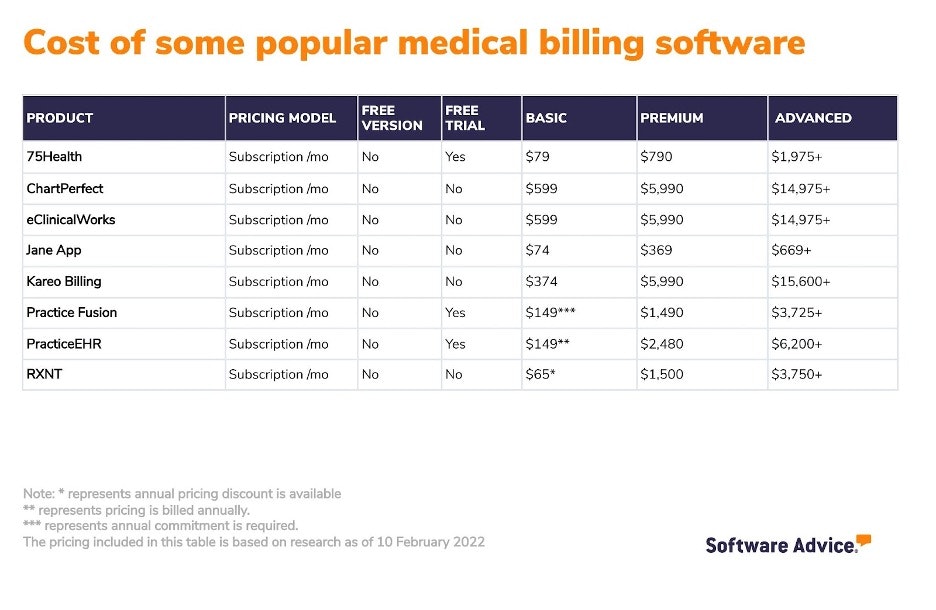
Only products with publicly-available pricing information were included in this table. We summarized publicly-available pricing sources, including vendor websites, as of February 10, 2022, beginning with the lowest monthly pricing (not including annual discounts) for packages that include the core functionality for a software category. We list pricing for more advanced packages (per user, when available) that also include the core software feature(s). As always, your company’s specific needs may differ and final pricing will vary.
A note on features:
Medical billing software helps healthcare providers track services, verify patients’ insurance, create and send invoices and submit claims. The core or basic functionalities include claims processing, claims scrubbing, and insurance verification.
3. Practice management software
What it is:
Practice management software automates activities such as patient care, scheduling, billing, claims processing, and other related operations for medical practices. By streamlining office workflows, doctors and their staff are able to spend more time with patients and less time on administrative tasks. Medical practice management applications can be utilized by private practices, community health centers, long term care, behavioral health facilities, hospitals, and other health care organizations.
How much does practice management software cost?
The cost of a practice management software varies based on a few aspects including features, size of the practice, and the type of software solution.
Self-hosted software is more common with the largest medical practices and established healthcare providers. On the other hand web-based software, also known as software-as-a-service or cloud based software, is more common with healthcare providers. This allows the provider to pay monthly or annually to access the practice management software.
Additional notes:
Practice management software cost starts as low as $29 and can go as high as $599 for a single user per month. For more users and advanced functionalities, healthcare companies can expect to pay anywhere from $99 to $15,225+ per month.
We classify the different pricing plans as basic, premium, and advanced. The price for these three pricing ranges goes from lowest to highest as the basic plan covers just a few basic features of the practice management software, whereas premium plans covers advanced features in addition to the basic features. Also, the advanced plan is the highest priced among the three due to more advanced features that support large teams or enterprises. For reference, below is a snapshot of some popular practice management software.
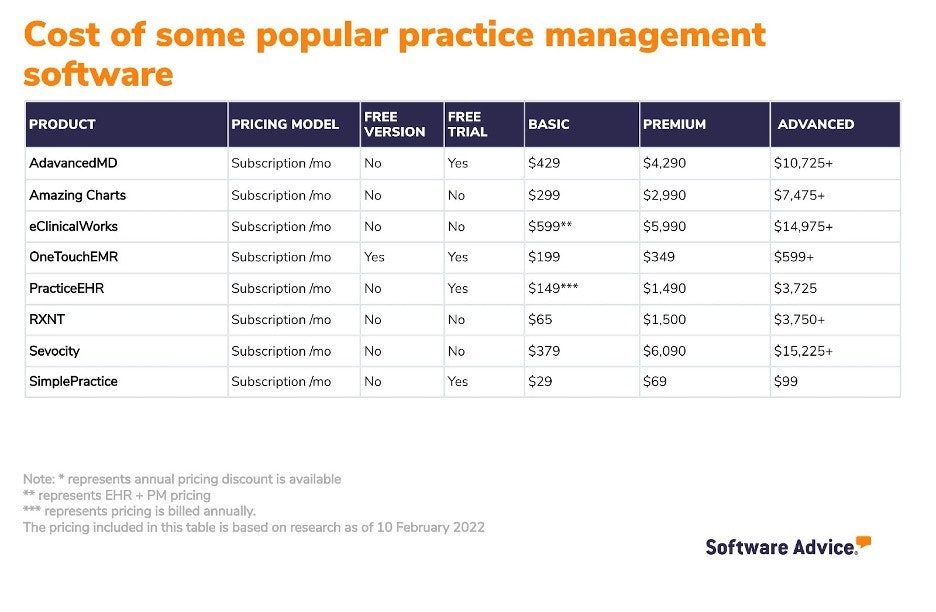
Only products with publicly-available pricing information were included in this table. We summarized publicly-available pricing sources including vendor websites as of February 10, 2022, beginning with the lowest monthly pricing (not including annual discounts) for packages that include the core functionality for a software category. We list pricing for more advanced packages (per user, when available) that also include the core software feature(s). As always, your company’s specific needs may differ and final pricing will vary.
A note on features:
Medical practice management software automates activities such as patient care, scheduling, billing, claims processing and other related operations for medical practices. The core or basic functionalities include patient records management, patient scheduling, and physician scheduling.
4. Telemedicine software
What it is:
Telemedicine software helps medical professionals diagnose or treat patients remotely using secure telecommunication tools such as video chat, phone, or email. It helps doctors evaluate and treat patients without an in-person visit. Telemedicine helps in minimizing additional expenses such as travel and accommodation while delivering clinical care via live video conferences.
How much does telemedicine software cost?
Telemedicine software cost primarily depends upon the choice of technology, as well as several other factors such as the number of users on the platform, the type of platform, available features, hosting options, and implementation scope.
Additional notes:
Telemedicine software cost starts as low as $29 and can go as high as $449 for a single user per month. For more users and advanced functionalities, healthcare companies can expect to pay around $59 to $929+ per month.
We classify the different pricing plans as basic, premium, and advanced. The price for these three pricing ranges goes from lowest to highest as the basic plan covers just a few basic features of the telemedicine software whereas premium plans covers advanced features in addition to basic features. Also, the advanced plan is the highest priced among the three due to more advanced features that support large teams or enterprises. For reference, below is a snapshot of some popular telemedicine software.
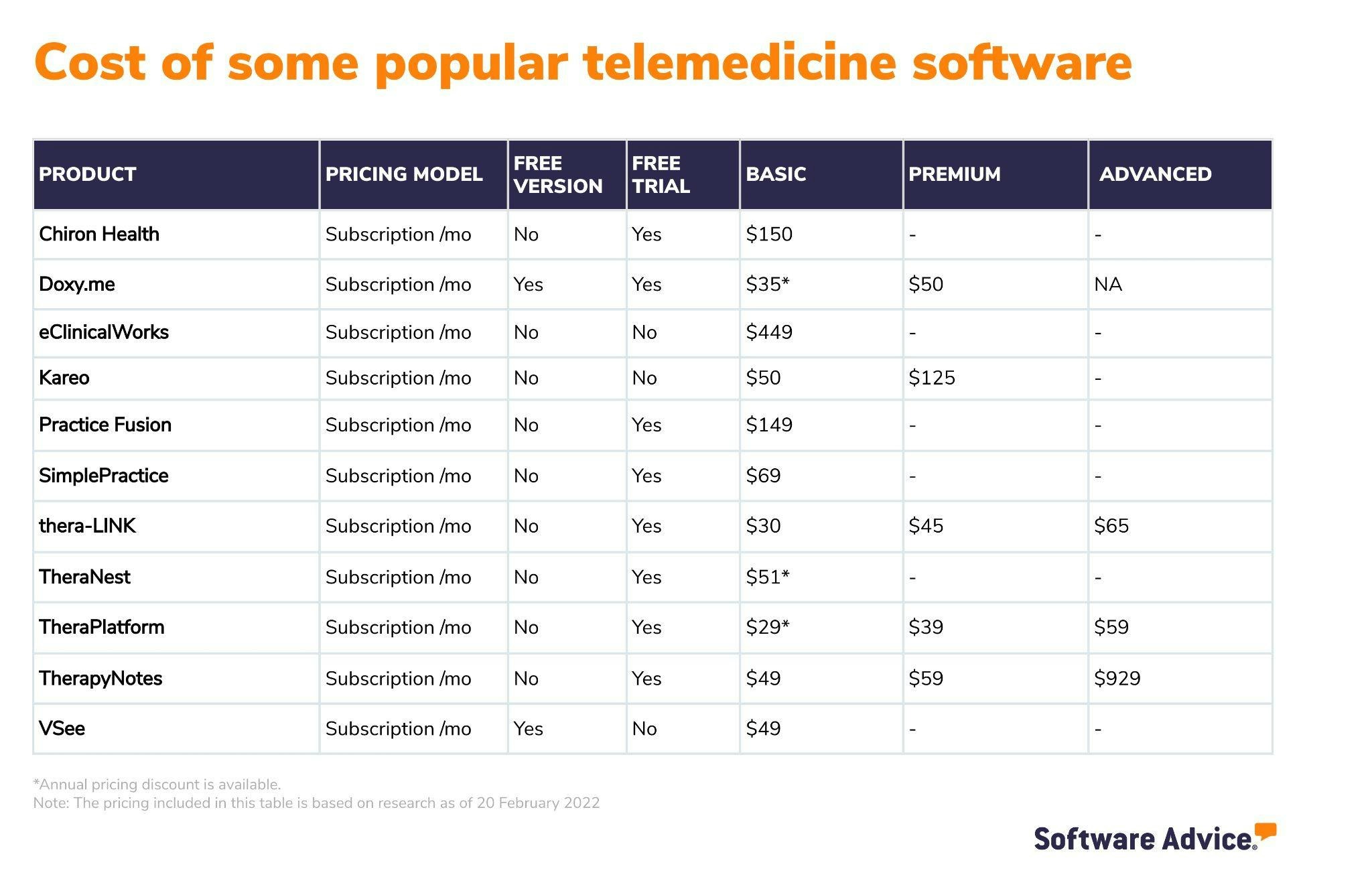
Only products with publicly-available pricing information were included in this table. We summarized publicly-available pricing sources, including vendor websites, as of February 10, 2022, beginning with the lowest monthly pricing (not including annual discounts) for packages that include the core functionality for a software category. We list pricing for more advanced packages (per user, when available) that also include the core software feature(s). As always, your company’s specific needs may differ and final pricing will vary.
A note on features:
Telemedicine software helps medical professionals diagnose or treat patients remotely using secure telecommunication tools, such as video chat, phone, or email. The core or basic functionalities are for medical purposes and include things such as appointment scheduling and remote treatment plans.
Additional fees to expect
Once you’re familiar with the different pricing models, there are additional fees to keep in mind when implementing a new healthcare software. These extra expenses are universal, regardless of your chosen vendor’s pricing model, so make sure you’re factoring the following into your budget:
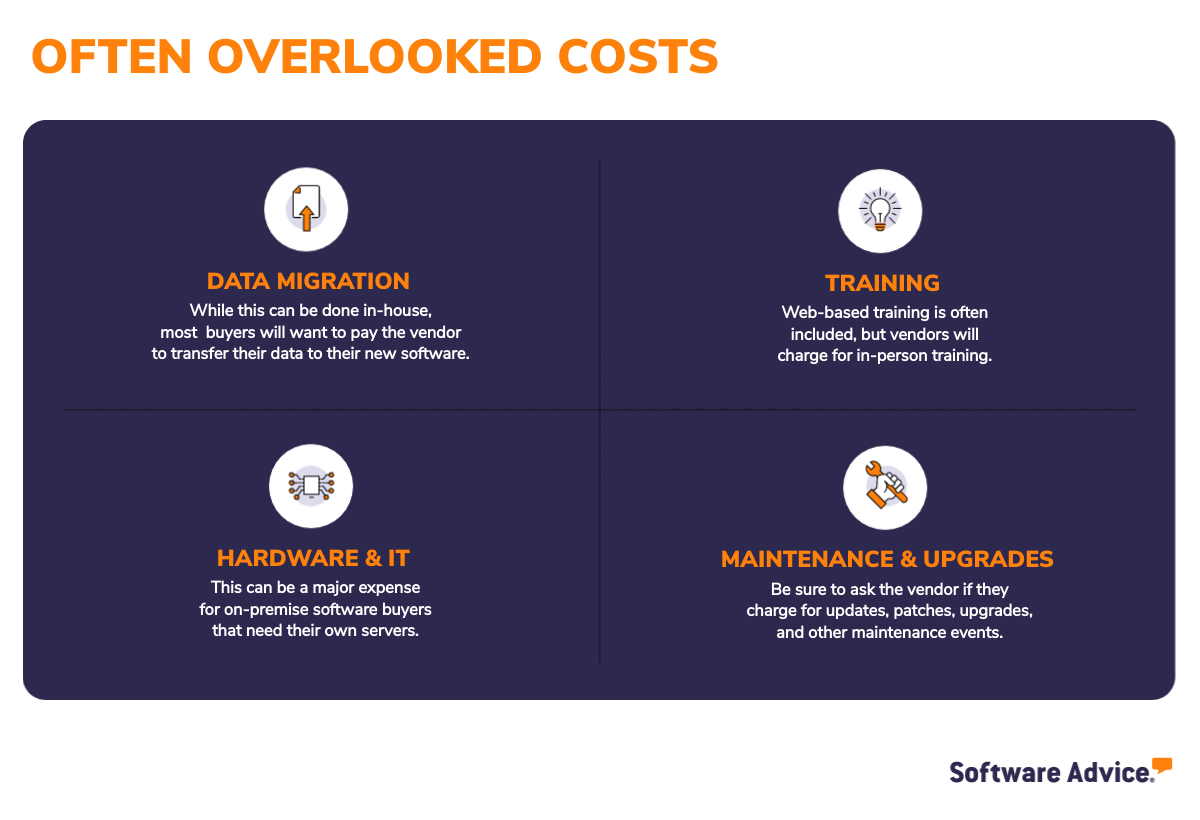
Data migration:Your current software vendor is able to extract patient data and export it as files that can then be imported into your new EMR. This is often a surprise cost for buyers, as vendors can charge between $25,000 or more for the service.
Training: Depending on how extensive staff training for the new system is, it can cost anywhere from nothing at all to several thousand dollars. These days, vendors provide a wealth of free online training materials, such as webinars and how-to videos, that can help cut down on costs. However, you might find it worthwhile to bring in an implementation specialist to get your staff up to speed as soon as possible in order to reduce costly downtime.
Maintenance and upgrades: It is important to know what maintenance and support services are being offered by the vendor and whether they are included in your software subscription or licensing fees. On the other hand, you might already have employees on your team to provide maintenance and support. It’s important to be sure of what support your software vendor offers, in case your team is unable to provide maintenance for the tool which could directly affect the ROI that your software was intended to deliver.
Hardware and IT: Is there any need to make additional purchases or enhancements to your existing infrastructure to implement the software? A common requirement might be the need to upgrade individual employee hardware, such as computers or mobile devices.
It’s important to take these often-overlooked costs into account before you begin evaluating vendors. This way, you can add them to your budget at the start.
What are the best healthcare software packages?
Do the different tools listed in this guide fall under your software budget? If they do, then you might as well compare their features and read real user reviews of more than 100 similar products listed on our category pages listed below.
Note: This article is intended to inform our readers about business-related concerns in the U.S. It is in no way intended to provide financial advice or to endorse a specific course of action. For advice on your specific situation, consult your accountant or financial consultant.